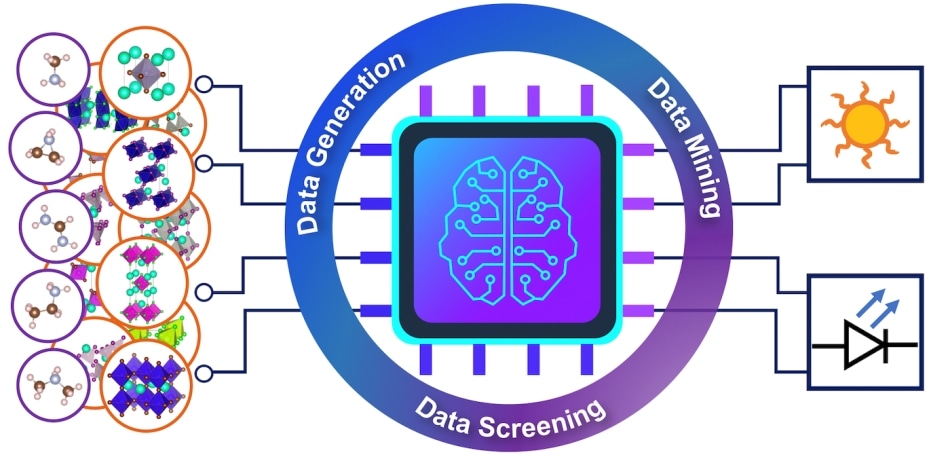May 23 2019
At the University of California San Diego, engineers have come up with a new high-throughput computational technique to design innovative materials for sophisticated LED devices and solar cells.
 Schematic illustration of the workflow for the high-throughput design of organic-inorganic hybrid halide semiconductors for solar cells and light emitting diodes. (Image credit: Yang lab/Energy & Environmental Science)
Schematic illustration of the workflow for the high-throughput design of organic-inorganic hybrid halide semiconductors for solar cells and light emitting diodes. (Image credit: Yang lab/Energy & Environmental Science)
The researchers’ method produced 23 new material candidates for LEDs and 13 new material candidates for solar cells. It was predicted by calculations that these innovative materials, known as hybrid halide semiconductors, would not only be stable but would also display exceptional optoelectronic characteristics. The researcher reported their findings on May 22nd, 2019 in the journal, Energy & Environmental Science.
Hybrid halide semiconductors are a special kind of materials that contain an inorganic framework in which organic cations are housed. They exhibit unusual material characteristics that are not present in inorganic or organic materials alone.
Hybrid halide perovskites are a subclass of these materials that have attracted a great deal of interest as potential materials for next-generation LED devices and solar cells, thanks to their inexpensive fabrication costs and excellent optoelectronic characteristics. On the other hand, hybrid perovskites are not highly stable and contain lead, rendering them inappropriate for commercial devices.
Looking for alternatives to perovskites, a research team utilized data mining, data screening methods, and computational tools and successfully discovered novel hybrid halide materials beyond perovskites that do not contain lead and are stable. The team was headed by Kesong Yang, a nanoengineering professor at the UC San Diego Jacobs School of Engineering.
We are looking past perovskite structures to find a new space to design hybrid semiconductor materials for optoelectronics.
Kesong Yang, Professor, Department of Nanoengineering, UC San Diego Jacobs School of Engineering
Yang’s group began by exploring through the two largest quantum materials databases called The Materials Project and AFLOW and examining all compounds that had a similar chemical composition as lead halide perovskites. The researchers subsequently extracted 24 prototype structures to utilize as templates for producing unique hybrid organic-inorganic materials structures. Following this, high-throughput quantum mechanics calculations were performed on the extracted prototype structures to construct a detailed quantum materials repository consisting of 4,507 theoretical hybrid halide compounds.
Using efficient data mining and data screening algorithms, Yang’s team rapidly identified 13 candidates for solar cell materials and 23 candidates for LEDs out of all the hypothetical compounds.
“A high-throughput study of organic-inorganic hybrid materials is not trivial,” stated Yang. The researchers took a number of years to create a comprehensive software framework integrated with data mining, data generation, and data screening algorithms for new hybrid halide materials. The team also took significant effort to make the software framework operate flawlessly with the software they employed for their high-throughput calculations.
Compared to other computational design approaches, we have explored a significantly large structural and chemical space to identify novel halide semiconductor materials.
Yuheng Li, Study First Author and PhD Candidate, Department of Nanoengineering, UC San Diego Jacobs School of Engineering
According to Li, this latest study can possibly motivate a new wave of experimental attempts to verify materials that were computationally predicted.
Moving ahead, Yang and his group are utilizing their high-throughput technique to find out innovative LED and solar cell materials from other forms of crystal structures. In addition, the researchers are creating novel data mining modules to find out other kinds of functional materials for spintronic and optoelectronic applications and for energy conversion.
Behind the Scenes: SDSC’s ‘Comet’ Supercomputer Powers the Research
Yang credits most of his study’s success to the utilization of the advanced Comet supercomputer at UC San Diego’s San Diego Supercomputer Center (SDSC).
Our large-scale quantum mechanics calculations required a large number of computational resources. Since 2016, we have been awarded with computing time—some 3.46 million core-hours on Comet, which made the project possible.
Kesong Yang, Professor, Department of Nanoengineering, UC San Diego Jacobs School of Engineering
Although the Comet supercomputer fueled the simulations in this work, SDSC staff also played a major role in his study, added Yang.
Jerry Greenberg, SDSC’s computational research specialist, and Ron Hawkins, SDSC’s director of industry relations, made sure that Yang and his group had as sufficient support as possible.
The investigators largely depended on the SDSC staff for the research’s installation and compilation of computational codes on the Comet supercomputer, which is funded by the National Science Foundation.
According to Yang, who was connected with SDSC through the Center’s Triton Shared Computing Cluster (TSCC) campus cluster at UC San Diego, the Comet supercomputer not only saved the researchers’ time but “the value of these awarded computing resources is about $115,600, which also saved our project a great deal of money.”
The paper is titled, “High-throughput computational design of organic-inorganic hybrid halide semiconductors beyond perovskites for optoelectronics.”
The study was supported by the National Science Foundation (ACI-1550404) and the Global Research Outreach (GRO) Program of Samsung Advanced Institute of Technology (award number 20164974). The ab-initio molecular dynamics calculations utilized computational resources provided by the Department of Defense High-Performance Computing Modernization Program (HPCMP).